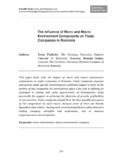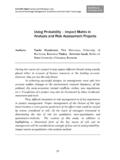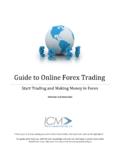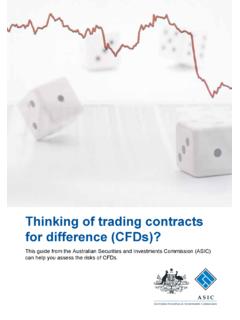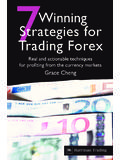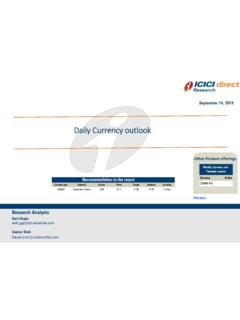Transcription of How to use Fibonacci retracement to predict forex …
1 How to use Fibonacci retracement to predict forex market Violeta Gaucan, Titu Maiorescu University, Bucharest, Romania Abstract: In the material below I have tried to explain how can be used Fibonacci retracement as an important tool to predict forex market. In this article I have included some graphic formats such as Fibonacci arcs, fan, channel, expansion, wich are created also with Fibonacci retracement and also rules to perfect chart plotting. I have analyzed some examples of Fibonacci retracements pattern in a downtrend and in an uptrend. In this article I have used and combine material from different sources trying to create a start point for those one of you that are interested. Keywords: Fibonacci ratios, downtrend, uptrend, suport and resistance levels Fib numbers (as they are often referred to) also appear in many aspects of nature such as the arrangement of leaves on a stem and the branching of trees.
2 Some day traders, swing traders and investors therefore say that the nature of the financial markets also manifest themselves in the structure of Fibonacci numbers. Now the big question: Do Fibonacci numbers have a dramatic influence on the financial markets? Should you use Fibonacci trading in your trading system to help with your stock market analysis? Therefore Fib numbers are indeed significant in trading if for no other reason than they become a self-fulfilling prophecy through their use by a massive number of Fibonacci forex , stock and futures traders. And those numbers can be used to calculate Fibonacci retracement levels. How? we will find together in the material below. History and mathematics Fibonacci (1175-1240) was one of the greatest mathematicians of the Middle Ages. He was born in Italy in Pisa town.
3 In 1202 after a trip to Egypt, he come back in Italy where it publishes a treatise on arithmetic and algebra named Incipit Liber Abacci ( compositus a Leonardo filius Bonacci Pisano). In this treaty introduces for the first time Arabic numeral system in Europe, and the numbers we use today: 0,1, 2, 3,..,9. Leonardo da Pisa, is rightly considered the first great original mathematician of Europe. In his many trips (Egypt, Syria, Greece, Sicily) he takes contact with Greek and Arabic culture. The story of numbers appears in Italy in 1202, with the advent of the book Liber Abaci, written by Leonardo Pisano, by then 27 years old. The book has 15 sheets heads, and are written entirely by hand, the pattern appeared 300 years later. Fibonacci book begins with notions about the identification numbers of the units digit of tens, hundreds, of thousands, etc.
4 In the last chapters we find calculations with integer numbers and fractions, proportions rules, extraction of square roots and higher order, then presents the solutions of linear and quadratic equations. Liber Abaci was filled with practical examples: calculation of financial accounting, corporate income, money exchange, conversion of weights, and the calculation of loan with interest. In terms of mathematic, Fibonacci numbers n are given by the following recurrence: 0 = 0, 1 = 1, n+1 = n-1 + n , n 1. Theorem 1. If 2 = + 1, then we have: n = n + n-1 , n 2. Argument: We will prove by induction after n. For n = 2 the relationship is trivial. We suppose that n > 2 we have n-1 = n-1 + n-2. Then n = n-1 = n-1( + 1) + n-2 = ( n-1 + n-2) + n-1 = n + n-1. Theorema 2. (Binet formula). The n-th term of the Fibonacci sequence is given by: n = nn +25125151, n 0.
5 Argument: Equation roots 2 = x + 1 are = 251+ and 1 - = 251 From theorem 1., we have: n = n + n-1 and (1 - n) = (1 ) n + n-1 Forward n (1 )n = 5 n , from where result the Binet formula. Fibonacci sequence in forex market Fibonacci retracement is a very popular tool used by many technical traders to help identify strategic places for transactions to be placed, target prices or stop losses. The notion of retracement is used in many indicators such as Tirone levels, Gartley patterns, Elliott Wave theory and more. After a significant price movement up or down, the new support and resistance levels are often at or near these lines. The Fibonacci sequence is simply beginning with the numbers 0 and 1, and then each number after that is the sum of the previous two. So .. 0 + 1 = 1 Then you take the sum of the last 2 numbers of the above equation and add them: 1 + 1 = 2 Then you take the sum of the last 2 numbers of the above equation and add them: 1 + 2 = 3 Then you take the sum of the last 2 numbers of the above equation and add them: 2 + 3 = 5 Then you take the sum of the last 2 numbers of the above equation and add them: 3 + 5 = 8 Then you take the sum of the last 2 numbers of the above equation and add them: 5 + 8 = 13 Then you take the sum of the last 2 numbers of the above equation and add them: 8 + 13 = 21.
6 And on it goes to infiinity! The Fibonacci sequence of numbers is as follows: 0, 1, 1, 2, 3, 5, 8, 13, 21, 34, 55, 89, 144, etc. Each term in this sequence is simply the sum of the two preceding terms and sequence continues infinitely. One of the remarkable characteristics of this numerical sequence is that each number is approximately times greater than the preceding number. This common relationship between every number in the series is the foundation of the common ratios used in retracement studies. Fibonacci ratios Fibonacci ratios are mathematical relationships, expressed as ratios, derived from the Fibonacci sequences. The key Fibonacci ratios are 0%, , , 50%, and 100%. F100% = 12510= + The key Fibonacci ratio of - also referred to as "the golden ratio" or "the golden mean" - is found by dividing any number in the sequence by the number that immediately follows it.
7 For example: 8/13 is approximately , and 55/89 is approximately F61,8% = 6180,02511 + The ratio is found by dividing any number in the sequence by the number that is found two places to the right. For example: 34/89 is approximately F38,2% = 381966,02512 + The ratio is found by dividing any number in the sequence by the number that is three places to the right. For example: 55/233 is approximately F23,6% = 236068,02513 + The 0 ratio is : F0% = 0251= + The ratio is derived from dividing the number 1 (third number in the sequence) by the number 2 (forth number in the sequence). F50% = 500000,021= The 50% retracement level is not really a Fibonacci ratio, but it is used because of the overwhelming tendency for an asset to continue in a certain direction once it completes a 50% retracement . Fibonacci retracement is created by taking two extreme points on a chart and dividing the vertical distance by the key Fibonacci ratios.
8 Is considered to be the start of the retracement , while is a complete reversal to the original part of the move. Once these levels are identified, horizontal lines are drawn and used to identify possible support and resistance. Other ratios The ratio is the result of subtracting from the number 1. F76,4% = 763932,025113 + The ratio is: F78,6% = 786151,025121 + Fig. 1. Fibonacci ratios. Graphic representation For reasons that are unclear, these ratios seem to play an important role in the stock market, just as they do in nature, and can be used to determine critical points that cause an asset's price to reverse. The direction of the prior trend is likely to continue once the price of the asset has retraced to one of the ratios listed above. The following chart illustrates how Fibonacci retracement can be used.
9 Notice how the price changes direction as it approaches the support/resistance levels. Fig. 2. Fibonacci retracement to the level on the EURUSD Fibonacci Retracements Pattern Stocks will often pull back or retrace a percentage of the previous move before reversing. These Fibonacci retracements often occur at three levels , 50%, and The use of Fibonacci retracement levels in online stock trading , stock market analysis (as well as futures, forex , etc.) serves to help determine how far one expects a market to retrace before continuing in the direction of the trend. It is often used with other technical analysis indicators such as a moving average, stochastics, RSI, candlestick patterns, etc. When using Fibonacci forex , stocks, futures and commodities can all be traded using the Fibonacci retracement of a trend. The first thing you should know about the Fibonacci tool is that it works best when the market is trending.
10 The idea is to go long (or buy) on a retracement at a Fibonacci support level when the market is trending up, and to go short (or sell) on a retracement at a Fibonacci resistance level when the market is trending down. In order to find these retracement levels, you have to find the recent significant Swing Highs and Swings Lows. Then, for downtrends, click on the Swing High and drag the cursor to the most recent Swing Low. For uptrends, do the opposite. Click on the Swing Low and drag the cursor to the most recent Swing High. Uptrend Fig. 3. A daily chart of AUD/USD Here we plotted the Fibonacci retracement Levels by clicking on the Swing Low at .6955 on April 20 and dragging the cursor to the Swing High at .8264 on June 3. Tada! The software magically shows you the retracement levels. As you can see from the chart, the retracement levels were.
